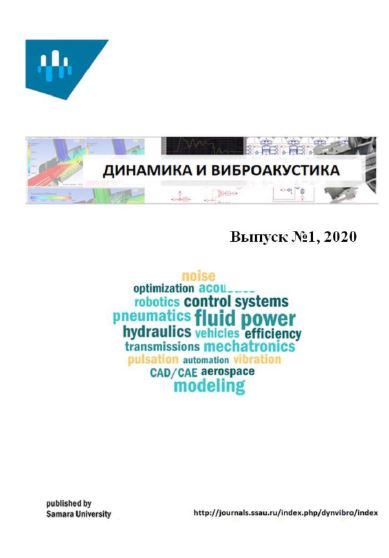Vol 6, No 1 (2020): 20.03.2020
- Year: 2020
- Published: 20.03.2020
- Articles: 5
- URL: https://dynvibro.ru/dynvibro/issue/view/411
-
Description:
опубликован 20.03.2020 г.
Full Issue
Articles
ANALYSIS OF DYNAMIC PROCESSES IN GEARE COUPLING OF HELICOPTER TAIL ROTOR TRANSMISSION
Abstract
The operation of the Mi-26 helicopters has shown that the operating time for rejection of splined gear couplings of the tail rotor transmission can differ by about 30 times. This fact is the reason for the search for dynamic processes that violate the stationary of the loading modes of the transmission couplings. Based on the analysis of the kinematics and dynamics of the clutch, it is shown in this work that when sliding in "tooth-spline" friction pairs, frictional self-oscillations can develop, leading to additional dynamic loads in the transmission elements and, as a consequence, a decrease in the working life of the clutches. The type of self-oscillations, their parameters (frequency, amplitude), as well as the stability of the transmission in relation to frictional self-oscillations depend on the tribological characteristics of the "tooth-slot" contact, which require additional experimental research. The results of this work can be useful in planning field tests and processing the data obtained.
 6-13
6-13


NEW APPROACHES IN MULTI-SHAFT GEAR DRIVES VIBRATION DIAGNOSTICS
Abstract
Presented studies are aimed at developing of new and improving of existing methods of vibration signal analysis to detect local gears damages during their operating.
The new method of calculating the modulation coefficient showed low sensitivity to the place of mounting of the vibration sensor and makes it possible to use in the absence of information about the vibration activity of the gear drive in the previous workable condition.
A technique for designing and using unique wavelets was developed. The technique reflects the specifics of real processes in the interaction of meshing teeth and adapted for gears vibration analysis. Using of unique wavelets can noticeably increase the wavelet coefficients sensitivity to changes in gears condition.
 14-24
14-24


THE INFLUENCE OF HYDRO BLASTING ON THE EN-DURANCE LIMIT OF SPECIMENS WITH A CUT UNDER BENDING AND STRETCHING-COMPRESSION
Abstract
The hydro blasting influence on an endurance limit of cylindrical specimens with circular cuts of a semicircular profile of 0,3 mm radius under bending and stretching-compression in a case of symmetric cycle has been examined. Specimens of 10 mm diameter for fatigue tests were made of steels 30ХГСА, 12Х18Н10Т, ЭИ961,45 and aluminum alloys В93, Д16Т.The influence of surface hardening on an endurance limit of specimens with cuts was valuated by two criteria: residual stresses on the concentrator surface and the average integral residual stresses calculated through the part’s dangerous section surface layer thickness equal the critical depth of a non-propagating fatigue crack.
On results of residual stresses and specimens with cuts endurance limits determination it’s been stated that coefficients of surface hardening influence on an endurance limit increase under bending and stretching-compression by two criteria are approximately equal. Besides, the coefficient of the influence by the average integral residual stresses criterion changes within essentially lesser limits than the coefficient of the influence by the residual stresses on the concentrator surface criterion. So the average integral residual stresses criterion should be used for the evaluation of a surface hardening influence on an endurance limit of parts with concentrators.
On an example of specimens within and without peening in a dangerous section it’s been shown that peening doesn’t influence the endurance limit of a surface hardened part. The compressive residual stresses only influence the endurance limit of these parts.
 25-34
25-34


Self-oscillation of the Froude pendulum (Numerical study)
Abstract
A numerical study of the self-oscillation of the Froude friction pendulum is presented. For comparison with approximate analytical or graphical solutions, the cubic approximation is used as one of the approximations of the friction characteristic; changes in the case of other approximations are shown.
By results of the conducted computational experiment was built characteristics of the amplitude of self-oscillations from dimensionless ratios, complexes of similarity, which showed the convergence of the estimated and actual (obtained by numerical integration) values of the amplitudes of oscillation for small values of friction and slope characteristics; if you increase the moment amplitude is also increased.
It is noted that the results of computer modeling will significantly depend on the design, manufacturing technology and operating conditions of the device in question.
 35-42
35-42


STUDY OF ELASTIC PROPERTIES OF A MAGNETO-RHEOLOGICAL ELASTOMER FOR VIBRO-INSULATION IN VACUUM
Abstract
Magnetorheological elastomer is used in vibration isolation and damping systems; it is promising to use a platform of active vibration isolation in a vacuum to provide vibration protection for the research object. Polymer is a composite material whose rheological properties can change under the influence of a directed magnetic field. For the correct operation of the platform, the constancy of mechanical properties is necessary, which can change during degassing with increasing temperature. The paper presents the results of studies of the mechanical properties of MRE with various compositions prior to degassing in a vacuum. It was found that the elastic modulus of the polymer directly depends on the concentration of filler particles, and no dependence on the presence of surfactants was found.
 43-47
43-47











